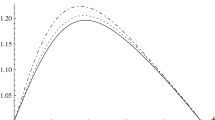Abstract
The Role of Comparative Advantage in Trade within Industries: A Panel Data Approach for the European Union. — A large share of EU member states trade is intra-industry trade (IIT) in the period 1985-1996; in particular, IIT is based on products differentiated in quality (vertical IIT). Moreover, exports from southern countries are located mainly at the lower end of the price-quality spectrum, whereas those countries with higher per capita incomes are located at the higher end. According to the vertical IIT models, we hypothesize that commercial specialization of members states over the quality spectrum within industries is explained by differences in technological, physical and human capital. The results show that comparative advantage is an important driver of the pattern of European trade within industries.
Similar content being viewed by others
References
Abd-el-Rahman, K. (1991). Firms’ Competitive and National Comparative Advantages as Joint Determinants of Trade Composition.Weltwirtschaftliches Archiv 127 (1): 83–97.
Balassa, B. (1966). Tariff Reductions and Trade in Manufactures among the Industrial Countries.American Economic Review 56 (3): 466–473.
Balassa, B. (1986). Intra-Industry Specialization: A Cross-Country Analysis.European Economic Review 30 (1): 7–42.
Balassa, B., and L. Bauwens (1987). Intra-Industry Specialization in a Multi-country and Multi-industry Framework.The Economic Journal 97 (December): 923–939.
Barro, R., and J. W. Lee (1993). International Comparisons of Educational Attainment.Journal of Monetary Economics 32 (3): 363–394.
Benhabib, J., and M. Spiegel (1994). The Role of Human Capital in Economic Development: Evidence from Aggregate Cross-Country Data.Journal of Monetary Economics 34 (2): 143–173.
Blanes, V., and C. Martin (2000). The Nature and Causes of Intra-industry Trade: Back to the Comparative Advantage Explanation? The Case of Spain.Weltwirtschaftliches Archiv 136 (3): 423–441.
Brülhart, M., and R. Hine (1999).Intra-Industry Trade and Adjustment. The European Experience. London: Macmillan.
Cañada, A., and A. Carmena (1991). La Integración en la CEE y los Cambios en el Sistema Fiscal-arancelario: Algunas Repercusiones sobre la Competitividad de la Economía Española (1986-1989). Working Paper 9101. Fundación Empresa PÚblica, Madrid.
Coe, D. T., and E. Helpman (1995). International R&D Spillovers.European Economic Review 39 (5): 859–887.
Davis, D. R. (1995). Intra-Industry Trade: A Heckscher-Ohlin-Ricardo Approach.Journal of International Economics 39 (3): 201–226.
Díaz Mora, C. (2001).El Impacto Comercial de la Integración Económica Europea en el Periodo 1985-1996. Madrid: Comité Económico y Social.
Dollar, D. (1993). Technological Differences as a Source of Comparative Advantage.American Economic Review 83 (2): 431–435.
Falvey, R. E. (1981). Commercial Policy and Intra-Industry Trade.Journal of International Economics 11 (4): 495–511.
Falvey, R., and H. Kierzkowski (1987). Product Quality, Intra-Industry Trade and (Im)Perfect Competition. In H. Kierzkowski (ed.),Protection and Competition in International Trade. Oxford: Blackwell.
Flam, H., and E. Helpman (1987). Vertical Product Differentiation and North-South Trade.American Economic Review 77 (5): 810–822.
Fontagné, L., M. Freudenberg, and N. Péridy (1997). Trade Patterns Inside the Single Market. Working Paper 97-07. CEPII.
Gandoy, R., and C. Díaz Mora (2000): Efectos Integración Económica: Efectos Comerciales. In R. Myro (ed.),Economía Europea: Crecimiento, Integración y Transformaciones Sectoriales. Madrid: Civitas.
Globerman, S., and J. W. Dean (1990). Recent Trends in Intra-Industry Trade and Their Implications for Future Trade Liberalization.Weltwirtschaftliches Archiv 126 (1): 25–49.
Greenaway, D. (1984). The Measurement of Product Differentiation in Empirical Studies of Trade Flows. In H. Kierzkowski (ed.),Monopolistic Competition and International Trade. Oxford: Oxford University Press.
Greenaway, D., and R. C. Hine (1991). Intra-Industry Specialization, Trade Expansion and Adjustment in the European Economic Space.Journal of Common Market Studies 29 (6): 603–622.
Greenaway, D., and Ch. Milner (1986).The Economics of Intra-Industry Trade. Oxford: Blackwell.
Greenaway, D., and J. Torstensson (1998). Economic Geography, Comparative Advantage and Trade within Industries: Evidence from the OECD. CEPR Discussion Paper 1857. London.
Greenaway, D., R. C. Hine, and C. Milner (1994). Country-specific Factors and the Pattern of Horizontal and Vertical Intra-Industry Trade in the U. K.Weltwirtschaftliches Archiv 130 (1): 77–100.
Grubel, H. G., and P. J. Lloyd (1975).Intra-Industry Trade, The Theory and Measurement of International Trade in Differentiated Products. London: Macmillan.
Harrigan, J. (1997). Technology, Factor Supplies and International Specialization: Estimating the Neoclassical Model.American Economic Review 87 (4): 477–494.
Hausman, J. (1978). Specification Tests in Econometrics.Econometrica 46 (6): 1251–1271.
Helpman, E. (1981). International Trade in the Presence of Product Differentiation, Economies of Scale and Monopolistic Competition.Journal of International Economics 11 (3): 306–340.
Helpman, E., and P. Krugman (1985).Market Structure and Foreign Trade. Cambridge, Mass: MIT Press.
Krugman, P. (1979). Increasing Returns, Monopolistic Competition and International Trade.Journal of International Economics 9 (4): 469–479.
Krugman, P. (1991).Geography and Trade. Cambridge, Mass: MIT Press.
Lancaster, K. (1980). Intra-Industry Trade under Perfect Monopolistic Competition.Journal of International Economics 10(2): 151–175.
Learner, E. (1984).Sources of Comparative Advantage. Cambridge, Mass: MIT Press.
Motta, M. (1990). Recent Models of International Trade and Distributional Gains from Integration.Rivista Internationale di Scienze Economiche e Commerciali 37 (8): 713–736.
Myro, R. (2000):Economia Europea: Crecimiento, Integración y Transformaciones Sectoriales. Madrid: Civitas.
Myro, R., and R. Gandoy (1999). El Sector Industrial. In J. L. García Delgado (ed.),Lecciones de Economía Española. Madrid: Civitas.
Myro, R., and C. Díaz Mora (2001). The Integration of Spain in the European Union: Main Industrial Effects. Institute Universitario Ortega y Gasset, Working Paper 0101 (European Economy Studies). Madrid.
Shacked, A., and J. Sutton (1984). Natural Oligopolies and International Trade. In H. Kierzkowski (ed.),Monopolistic Competition and International Trade. Oxford: Oxford University Press.
Summers, R., and A. Heston (1991). The Penn World Tables (Mark 5): An Expanded Set of International Comparisons, 1950-88.Quarterly Journal of Economics 106 (2): 327–336.
Torstensson, J. (1996). Can Factor Proportions Explain Vertical Intra-industry Trade.Applied Economic Letters 3: 307–309.
Torstensson, J. (1999). Intra-industry Trade: What Does the Theory Predict and How Robust Are the Empirical Estimates? In M. Brülhart and R. C. Hine (eds.),Intraindustry Trade and Adjustment. The European Experience. London: Macmillan.
White, H. (1980). A Heteroscedasticity-Consistent Covariance Matrix Estimator and a Direct Test for Heteroscedasticity.Econometrica 48 (4): 817–838.




